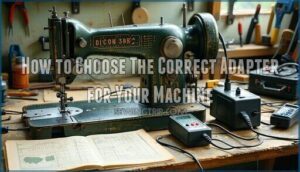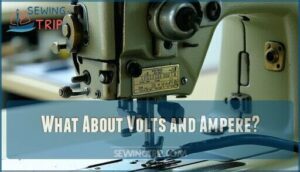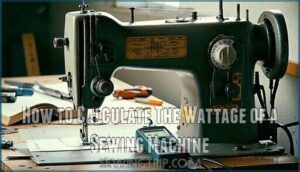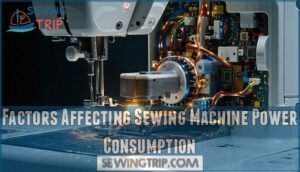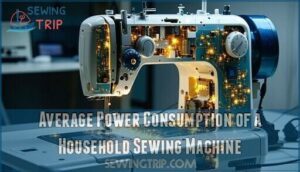This site is supported by our readers. We may earn a commission, at no cost to you, if you purchase through links.
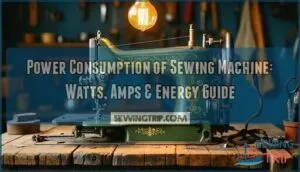
Basic mechanical models use around 70-85 watts, while computerized versions with fancy features can pull 100-120 watts. The motor does the heavy lifting here – it works harder when you’re stitching through thick denim compared to lightweight cotton.
If you’re planning to sew in an RV or boat, this matters more since every watt counts. Industrial machines are power-hungry beasts, consuming 400-1000 watts.
But there’s more than just watts that warrant examination.
Table Of Contents
- Key Takeaways
- How Much Power Does a Sewing Machine Consume?
- — What if I Cannot Find The Watt Number?
- — The Motor Uses Most of The Power
- Using a Sewing Machine on Boats, in RVs, Etc
- How to Choose The Correct Adapter for Your Machine
- What About Volts and Ampere?
- How to Calculate The Wattage of a Sewing Machine
- Factors Affecting Sewing Machine Power Consumption
- Average Power Consumption of a Household Sewing Machine
- How Many Watts Does an Industrial Sewing Machine Use?
- Frequently Asked Questions (FAQs)
- Conclusion
Key Takeaways
- Your sewing machine won’t spike your electricity bill – most home models use just 75-150 watts (about the same as a bright light bulb), costing roughly 30 cents monthly, even with 10 hours of daily use.
- The motor does the heavy lifting – it accounts for 80-90% of your machine’s power consumption and works harder when you’re stitching through thick fabrics, like denim, versus lightweight cotton.
- You can easily calculate missing wattage – if you can’t find the watts on your machine’s label, simply multiply the volts by amps (usually found on the back sticker) to get your power consumption.
- Off-grid sewing requires proper planning – you’ll need a quality pure sine wave inverter to convert 12V battery power for RV or boat use, as cheap modified sine wave units can damage your motor.
How Much Power Does a Sewing Machine Consume?
When you’re wondering about sewing machine power consumption, you’ll find most home models are surprisingly energy-efficient.
Most home sewing machines use surprisingly little power – often less than a bright light bulb!
Your typical household sewing machine uses between 75-150 watts, with most averaging around 100 watts.
That’s less electricity than a bright light bulb!
This wattage overview shows these machines won’t break your budget.
Even heavy users spending 10 hours daily only rack up about 30 cents monthly in electricity costs.
The energy efficiency comes from smart motor design that adjusts power based on fabric thickness and stitching demands.
Different machine types consume varying amounts of power.
Basic mechanical models use 50-100 watts, while computerized versions with LCD screens and automatic features consume 75-150 watts.
Embroidery machines typically range from 100-250 watts due to their complex operations.
A sewing machine’s power consumption depends on its voltage and amperage.
Your sewing machine electricity usage depends on actual runtime, not idle time.
Most power sources handle these requirements easily since sewing machine energy consumption remains minimal compared to major appliances, making cost savings automatic for creative hobbyists.
— What if I Cannot Find The Watt Number?
Sometimes you’ll find yourself staring at your sewing machine like it’s keeping secrets from you. The wattage isn’t always printed in bold letters where you’d expect it. Don’t panic – there’s a simple workaround that’ll get you the numbers you need.
First, flip your machine around and check for that machine sticker on the back or bottom. It’s usually there, hiding in plain sight with all the sewing machine specifications you need. Look for "W" or "Watts" – that’s your sewing machine power rating right there.
Can’t find it? Here’s where basic math saves the day. Find the volts and amps instead – they’re almost always listed on the sewing machine electrical input label. To calculate wattage, simply multiply volts by amperage needed. A sewing machine’s power consumption varies depending on the model. For example, if your machine shows 120V and 1A, your sewing machine wattage is 120 watts. This formula gives you the exact power consumption without guesswork.
— The Motor Uses Most of The Power
Your sewing machine’s motor is the real energy hog in the equation. This hardworking component drives the needle, feeds fabric, and powers various mechanisms, accounting for roughly 80-90% of your machine’s total sewing machine power consumption.
The motor is your machine’s power-hungry workhorse, devouring 80-90% of every watt while driving needles through fabric.
Motor power usage directly correlates with the workload you’re demanding from it. When you’re stitching through thick denim or multiple layers, the motor works harder, drawing more watts to generate the necessary torque and maintain consistent speed.
Lighter fabrics require less effort, naturally reducing sewing machine wattage. Think of it like your car engine – city driving versus highway cruising demands different power levels.
Regular motor maintenance tips include cleaning lint buildup and proper oiling to prevent unnecessary strain. If the motor runs but nothing moves, you may have a broken drive belt.
Efficient motor types, like newer direct-drive models, optimize performance while reducing overall sewing machine power requirements. Poor maintenance leads to overheating prevention issues and increased energy consumption as your sewing machine motor struggles against resistance.
Using a Sewing Machine on Boats, in RVs, Etc
Off-grid sewing adventures require careful power planning. Your sewing machine voltage and wattage needs don’t disappear just because you’re cruising or camping.
RV power sources and boat sewing setup demand attention to detail. Most machines need 100-150 watts, but your 12V batteries can’t handle standard household voltage directly. You’ll need a quality inverter to convert battery power safely.
| Power Source | Voltage Output | Best For |
|---|---|---|
| Shore Power | 110-120V AC | All machines |
| Inverter + Batteries | 110-120V AC | Light sewing |
| Portable Generators | 110-120V AC | Heavy projects |
Battery powered sewing works best with pure sine wave inverters. Cheap modified sine wave units can fry your motor faster than you can say "backstitch." When flying, remember that TSA allows sewing needles in carry-on baggage.
Voltage converters help international machines, while portable generators offer unlimited runtime. Calculate your total power draw including lights and accessories before heading out on your mobile sewing journey.
How to Choose The Correct Adapter for Your Machine
When your sewing machine needs a power adapter, getting the right match isn’t just important—it’s essential for your machine’s safety and performance. The wrong adapter can damage your equipment or create hazardous conditions.
Start by checking your machine’s voltage requirements, typically found on a label or in the manual. Most home machines need 110-120V, while some international models require 220-240V. Next, verify the wattage requirements to guarantee your adapter can handle the load without overheating.
Here’s your adapter selection checklist:
- Match voltage exactly – Your adapter’s output must align with your machine’s input voltage
- Check connector polarity – Most adapters use center-positive connections, but verify yours
- Verify wattage capacity – Choose an adapter rated higher than your machine’s consumption
- Consider safety standards – Look for UL, CE, or similar certifications for reliable operation
For peak charging speeds, consider device power requirements for your sewing machine. For international use, voltage regulators help bridge compatibility gaps between different electrical systems.
What About Volts and Ampere?
Understanding electrical specifications helps you pick the right adapter and avoid circuit problems.
Voltage Explained: Most home machines run on 110-120 volts from standard outlets, while industrial models need 220-240 volts. Amperage Defined shows how much electrical current flows through your machine. Home sewing machines typically draw 1-2 amps during basic operation.
The correct voltage guarantees proper sewing machine functioning.
| Specification | Home Use | Industrial Use |
|---|---|---|
| Voltage | 110-120V | 220-240V |
| Amperage | 1-2 amps | 4-10 amps |
| Electrical Outlet | Standard wall | Heavy-duty |
| Adapters Needed | Rare | Often required |
| Calculating Power | Simple math | Complex loads |
Voltage Compatibility matters when choosing adapters. Check your electrical outlet’s voltage rating before plugging in any machine.
How to Calculate The Wattage of a Sewing Machine
You don’t need a degree in electrical engineering to figure out your sewing machine’s power consumption. The wattage calculation is straightforward once you know the basic formula.
Most machines display power information on labels or in manuals, but sometimes you’ll need to do the math yourself.
Here’s what you need to calculate sewing machine wattage:
- Find the voltage and amperage – Check your machine’s nameplate or manual for these numbers
- Use the wattage formula – Simply multiply Volts × Amperes to get watts (120V × 1.5A = 180W)
- Consider online calculators – Power consumption calculators can verify your math and provide cost estimates
If you can’t locate power labels on your machine, a multimeter helps measure the actual amps during operation. Sewing machines typically use around 100 watts, making them relatively low-power devices.
Remember, this calculation guarantees you’re using the right power source and prevents electrical headaches down the road.
Factors Affecting Sewing Machine Power Consumption
Several key factors influence your sewing machine’s power consumption, making the difference between a lightweight energy sipper and a power-hungry workhorse.
Motor Efficiency plays the biggest role in sewing machine energy consumption. Older machines often waste electricity through inefficient motors, while newer models adjust power based on your actual workload. You’ll notice this difference when tackling thick fabrics versus lightweight materials.
Machine Age directly impacts sewing machine efficiency. Vintage machines weren’t designed with energy conservation in mind, so they typically draw more sewing machine amps than modern counterparts. A sticker on the back often indicates machine power requirements.
Here are the main factors affecting sewing machine power consumption:
- Lighting Type – LED lights consume less electricity than traditional bulbs
- Usage Patterns – Continuous high-speed sewing increases wattage demands
- Fabric Density – Heavy materials force motors to work harder
- Built-in Features – Embroidery units and computerized functions boost sewing machine wattage
Smart shopping means checking the amp rating before buying. Computerized models with multiple features typically use more power, though advancing technology continues improving overall sewing machine power consumption efficiency.
Average Power Consumption of a Household Sewing Machine
Most household sewing machines consume between 50-100 watts per hour, with basic models hitting the lower end and computerized versions reaching 150 watts.
Your domestic sewing machine power consumption depends on feature impact – LED displays, multiple motors, and built-in lights boost electricity usage.
Wattage averages vary by brand efficiency, but expect around 100 watts for standard models.
A sewing machine’s power consumption is largely due to motor energy usage.
Usage patterns matter too – continuous operation costs roughly a penny per hour at typical rates, which is a significant energy labeling aspect that helps compare average power consumption when shopping for new machines, considering the overall power consumption and electricity usage to make an informed decision about energy efficiency.
How Many Watts Does an Industrial Sewing Machine Use?
Industrial sewing machines pack serious punch with their sewing machine wattage range of 300-550 watts, though some heavy-duty models consume up to 1,500+ watts. That’s quite a jump from your home machine’s 100-watt appetite.
- Older models draw around 430 watts per hour before 1993
- Direct drive savings dropped consumption to 180 watts by 2000
- Heavy-duty consumption peaks at 2,500 watts for demanding tasks
- Wattage technological impact continues reducing industrial machine wattage through modern efficiency upgrades
These machines often utilize lock stitch mechanisms for durable seams.
Your sewing machine power rating determines production capacity and operating costs.
Frequently Asked Questions (FAQs)
How much electricity does a sewing machine use?
Like a lightbulb’s gentle glow, your sewing machine won’t break the bank. Most home machines use 75-150 watts, costing you roughly 30 cents monthly for 10 hours of stitching bliss.
Do industrial sewing machines use a lot of electricity?
Yes, you’ll notice industrial sewing machines consume substantially more electricity than home models. They typically use 300-500 watts compared to your household machine’s 100 watts, making them power-hungry workhorses.
How many Watts Does a sewing machine use?
Most home sewing machines use between 75-150 watts, averaging around 100 watts.
You’ll find computerized models consume slightly more at 75-150 watts, while basic mechanical machines stay in the 50-100 watt range.
How do you calculate the power consumption of a sewing machine?
You multiply your machine’s wattage by hours used, then by your electricity rate per kilowatt-hour. Find watts on the machine’s label, convert to kilowatts by dividing by 1,000, then calculate costs.
Why do sewing machines use a lot of power?
Actually, sewing machines don’t use a lot of power.
Most home models consume just 75-150 watts—less than your microwave.
You’re running an energy-efficient appliance that won’t spike your electricity bill substantially.
How much power does a button sewing machine use?
Button sewing machines typically consume 50-100 watts of power, similar to standard home sewing machines.
You’ll find they’re quite energy-efficient, costing only pennies per hour to operate while handling your lightweight buttonhole tasks, making them very cost-effective.
What Are Some Ways I Can Reduce the Power Consumption of My Sewing Machine?
Smart sewing strategies save significant energy.
You’ll cut consumption by using LED lighting, maintaining proper lubrication, choosing appropriate speed settings, and turning off your machine between projects.
Regular cleaning and part replacement optimize efficiency too.
Is It Safe to Use an Extension Cord With My Sewing Machine?
Yes, you can safely use an extension cord with your sewing machine if it’s heavy-duty and rated for the machine’s amperage.
Avoid lightweight cords that overheat and always plug directly into outlets when possible.
What Should I Look for When Buying a Surge Protector for My Sewing Machine?
Surprisingly, many sewers experience power surges just when they’re finishing important projects.
You’ll want a surge protector with at least 1,000 joules protection, multiple outlets, and EMI/RFI filtering to safeguard your machine’s delicate electronics.
How many watts to run a sewing machine?
Most home sewing machines run on 75-150 watts, with 100 watts being typical. You’ll need about the same power as a bright light bulb to keep your machine humming along smoothly.
Conclusion
Ready to master your machine’s electrical needs? Understanding your sewing machine’s power consumption isn’t rocket science – it’s about matching watts to your projects and power source.
Whether you’re stitching lightweight fabrics at 70 watts or tackling heavy materials that push your machine to 120 watts, you now know what to expect.
Check your machine’s label, calculate your usage, and choose appropriate adapters. Smart power management keeps you sewing smoothly, whether at home or off-grid adventures, with sewing machine’s power consumption in mind, and using the right power source.
- https://sewingbecomeasy.com/how-much-power-does-it-take-to-run-a-sewing-machine/
- https://www.slashplan.com/sewing-machine-energy-calculator-cost-and-kwh-usage/
- https://www.quora.com/Does-an-electric-sewing-machine-consume-much-electricity
- https://www.eharrisgallery.com/how-many-amps-does-a-sewing-machine-use/
- https://www.rapidtables.com/calc/electric/watt-volt-amp-calculator.html


